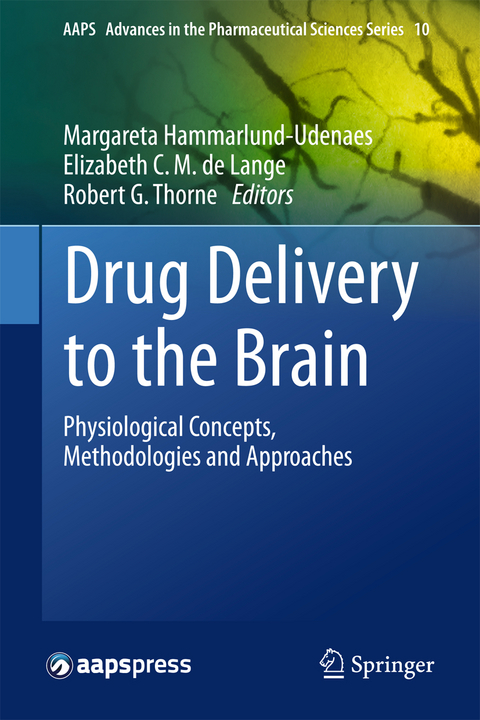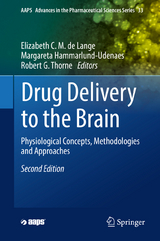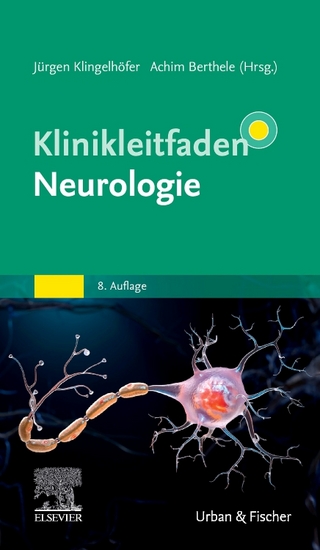
Drug Delivery to the Brain
Springer-Verlag New York Inc.
978-1-4614-9104-0 (ISBN)
- Titel erscheint in neuer Auflage
- Artikel merken
Margareta Hammarlund-Udenaes (PhD) is a Professor in Pharmacokinetics and Pharmacodynamics (PKPD) at Uppsala University and the Head of the Translational PKPD Group. Her research is focused at studying pharmacokinetic aspects of BBB transport of drugs in relation to CNS effects, which has led to the development of new concepts and methods within the BBB transport area, focusing on unbound drug relationships. Dr. Hammarlund-Udenaes is an Associate Editor of Pharmaceutical Research and a member of the Editorial Advisory Board of Journal of Pharmaceutical Sciences and Fluids and Barriers of the CNS. She became an American Association of Pharmaceutical Scientists’ Fellow in 2005. She is a frequent lecturer at conferences and in drug industry. Her company gives courses and advice in PKPD and BBB transport issues. She co-founded and has co-chaired several of the International Symposia on Microdialysis, and she is the Chair of the ‘Barriers of the CNS’ Gordon Conference in 2014. Elizabeth C.M. de Lange (PhD) is Head of the Target Site Equilibration Group at the Division of Pharmacology of the Leiden Academic Center for Drug Research (LACDR). Her research program focuses on the development of generally applicable predictive PKPD models on CNS drugs using advanced in vivo animal models and mathematical modeling techniques, with a number of recent successes. She is an Editorial Board member of the journal Fluids and Barriers of the CNS, and an Editorial Advisory Board member of the Journal of Pharmaceutical Sciences and of Pharmaceutical Research. She has been the cofounder and (co-)Chair at the 1st, 2nd and 5th International Symposia on Microdialysis, and has been the Chair of the 9th International Conference on Cerebral Vascular Biology (2011). Among many other functions within the American Association of Pharmaceutical Scientists, she is the 2014 Chair of the Annual Meeting Programming Committee. With her company “In Focus” (www.infocus-ecmdelange.nl) she provides courses, training and advice on microdialysis, pharmacokinetics, BBB transport, intra-brain distribution and PKPD relationships. Robert G. Thorne (PhD) is an Assistant Professor in Pharmaceutical Sciences at the University of Wisconsin-Madison School of Pharmacy and also serves as a Trainer in the Neuroscience, Cellular & Molecular Pathology, and Clinical Neuroengineering Training Programs at the University of Wisconsin-Madison. Dr. Thorne was previously a research scientist and Faculty member in the Department of Physiology & Neuroscience at the New York University School of Medicine. His background includes a Ph.D. in Pharmaceutics (University of Minnesota) and a B.S. in chemical engineering (University of Washington). His research focuses on diffusive and convective transport within the CNS and the development, refinement and optimization of strategies for delivering biologics into the brain. He is a frequent invited speaker on topics related to CNS drug delivery for organizations within academia, foundations, and the biotechnology and pharmaceutical industry. Dr. Thorne is a founder and Council / Steering Committee member of the International Brain Barriers Society (http://www.ibbsoc.org/) as well as the 2016 Chair-elect for the ‘Barriers of the CNS’ Gordon Research Conference.
I. PHYSIOLOGY AND BASIC PRINCIPLES FOR DRUG HANDLING BY THE BRAIN
1. Anatomy and physiology of the blood-brain barriers
N Joan Abbott
2. Recent Progress in Blood-Brain Barrier and Blood-CSF Barrier Transport Research: Pharmaceutical Relevance for Drug Delivery to the Brain
Masanori Tachikawa, Yasuo Uchida, Sumio Ohtsuki and Tetsuya Terasaki
3. Blood-Brain Barrier (BBB) Pharmacoproteomics: A New Research Field Opened up by Quantitative Targeted Absolute Proteomics (QTAP)
Yasuo Uchida, Masanori Tachikawa, Sumio Ohtsuki And Tetsuya Terasaki
4. Drug Metabolism at the Blood-Brain and Blood-CSF Barriers
Xavier Declèves, Nathalie Strazielle, Jean-Michel Scherrmann and Jean-François Ghersi-Egea
II. PHARMACOKINETIC CONCEPTS AND METHODS FOR STUDYING DRUG DELIVERY ACROSS THE BLOOD-BRAIN BARRIER
5. Pharmacokinetic Concepts in Brain Drug Delivery
Margareta Hammarlund-Udenaes
6. In vitro models of blood-brain barriers
N Joan Abbott, Diana EM Dolman, Siti R Yusof and Andreas Reichel
7. In situ and in vivo animal models
Quentin Smith and Ramakrishna Samala
8. Principles of PET and its Role in Understanding Drug Delivery to the Brain
Stina Syvänen and Roger N. Gunn
9. PKPD Aspects of Brain Drug Delivery in a Translational Perspective
Elizabeth C.M. de Lange
III. INDUSTRIAL APPROACHES FOR INVESTIGATION OF POTENTIAL CENTRAL NERVOUS SYSTEM DRUGS
10. Drug Discovery Methods for Studying Brain Drug Delivery and Distribution
Irena Loryan and Margareta Hammarlund-Udenaes
11. Prediction of Drug Exposure in the Brain from the Chemical Structure
Markus Fridén
12. Integrated Approach to Optimizing CNS Penetration in Drug Discovery: From the old to the new Paradigm and Assessment of Drug-Transporter Interactions
Andreas Reichel
13. Pharmacoeconomic Considerations in CNS Drug Development
David Gray
IV. STRATEGIES FOR IMPROVED CENTRAL NERVOUS SYSTEM DRUG DELIVERY
14. Intranasal Drug Delivery to the Brain
Jeffrey J. Lochhead and Robert G. Thorne
15. Blood-To-Brain Drug Delivery using Nanocarriers
Pieter J. Gaillard, Corine C. Visser, Marco de Boer, Chantal C.M. Appeldoorn and Jaap Rip
16. Development of new Protein Vectors for the Physiologic Delivery of Large Therapeutic Compounds to the CNS
Reinhard Gabathuler
17. CNS Gene Therapy Utilizing Intravenously Administered Viral Vectors
Adam K. Bevan and Brian K. Kaspar
18. Neurosurgical Approaches: Drug Infusion Directly into the Parenchyma or Cerebrospinal Fluid
Krystof Bankiewicz
19. Osmotic Opening of the BBB for Drug Treatment of Brain Tumors (Focus on Methodological Issues)
David Fortin
20. Emerging Engineering Technologies for Opening the BBB
Elisa E. Konofagou
V. BRAIN DRUG DELIVERY IN DISEASE CONDITIONS
21. Disease Influence on BBB Transport in Inflammatory Disorders
Geert Schenk, Gijs Kooij, Arie Reijerkerk and Helga de Vries
22. Disease Influence on BBB Transport in Neurodegenerative Disorders
Elizabeth C.M. de Lange
23. Drug Delivery in the Context of Stroke and Brain Trauma
Richard F. Keep, Jianming Xiang, Ningna Zhou and Anuska V. Andjelkovic
24. Which Drug or Drug Delivery Method can change Clinical Practice for Brain Tumor Therapy?
Tali Siegal
Appending – Primer on Central Nervous System Structure / Function and the Vasculature, Ventricular System and Fluids of the Brain. Robert Thorne
| Erscheint lt. Verlag | 4.12.2013 |
|---|---|
| Reihe/Serie | AAPS Advances in the Pharmaceutical Sciences Series ; 10 |
| Zusatzinfo | 126 Illustrations, color; 24 Illustrations, black and white; XX, 731 p. 150 illus., 126 illus. in color. |
| Verlagsort | New York, NY |
| Sprache | englisch |
| Maße | 155 x 235 mm |
| Themenwelt | Medizin / Pharmazie ► Medizinische Fachgebiete ► Neurologie |
| Medizin / Pharmazie ► Medizinische Fachgebiete ► Pharmakologie / Pharmakotherapie | |
| Medizin / Pharmazie ► Pharmazie | |
| Naturwissenschaften ► Chemie ► Technische Chemie | |
| Technik | |
| Schlagworte | blood-brain barrier • drug delivery blood-brain barrier • Transporters |
| ISBN-10 | 1-4614-9104-5 / 1461491045 |
| ISBN-13 | 978-1-4614-9104-0 / 9781461491040 |
| Zustand | Neuware |
| Informationen gemäß Produktsicherheitsverordnung (GPSR) | |
| Haben Sie eine Frage zum Produkt? |
aus dem Bereich



